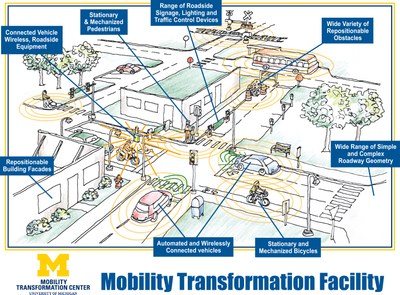How do you test automated vehicles?
Enabling researchers to test how automated and networked vehicles respond to rare but dangerous traffic events and road conditions, the University of Michigan is building a 32 acre simulated city centre and four-lane highway. Researchers have said that the patent-pending Mobility Transformation Facility is a vital step in making sure these advanced vehicles can operate safely in the real world.
Operated by the university's Mobility Transformation Center - a public/private partnership that aims to change how people and goods move around - this is the only such automated vehicle test facility on university grounds, say officials. It will open later this year on the North Campus.
The test environment will feature merge lanes, stoplights, intersections, roundabouts, road signs, a railroad crossing, building facades, construction barrels and even a mechanical pedestrian. It will model the connected and automated mobility system that the centre aims to facilitate for the future. With vehicles that communicate with each other and the world around them, a system such as this could dramatically reduce crashes, ease traffic and reduce pollution and energy use.
“We will actually be writing code for the test facility,” said Edwin Olson, Assistant Professor, Computer Science and Engineering. “We’ll be able to trigger tricky traffic signal timings, or a pedestrian stepping into the intersection at just the wrong time, for example.”

Michigan Engineering researchers will initially use the facility to run tests on an automated Ford Fusion hybrid, working with the motor company to develop sensors and mapping technology. While Ford picture a future in which automated technologies enhance the abilities of drivers, others are looking to completely eliminate the human element. Either way, many years of testing are required - and facilities like this are very rare in the auto industry.
Ryan Eustice, Associate Professor, Naval Architecture and Marine Engineering, commented: “The type of testing we’re talking about doing - it’s not possible to do today in the university infrastructure. Every time a vehicle comes around the loop, it can hit something unusual. That will give us a leg up on getting these vehicles mature and robust and safe.”
“Today reminds me of when I was a young boy and used to watch The Jetsons. We’re not doing flying cars here, but I think we’re doing something more important... and almost as impressive,” concludes David Munson, the Robert. J. Vlasic Dean of Engineering.


